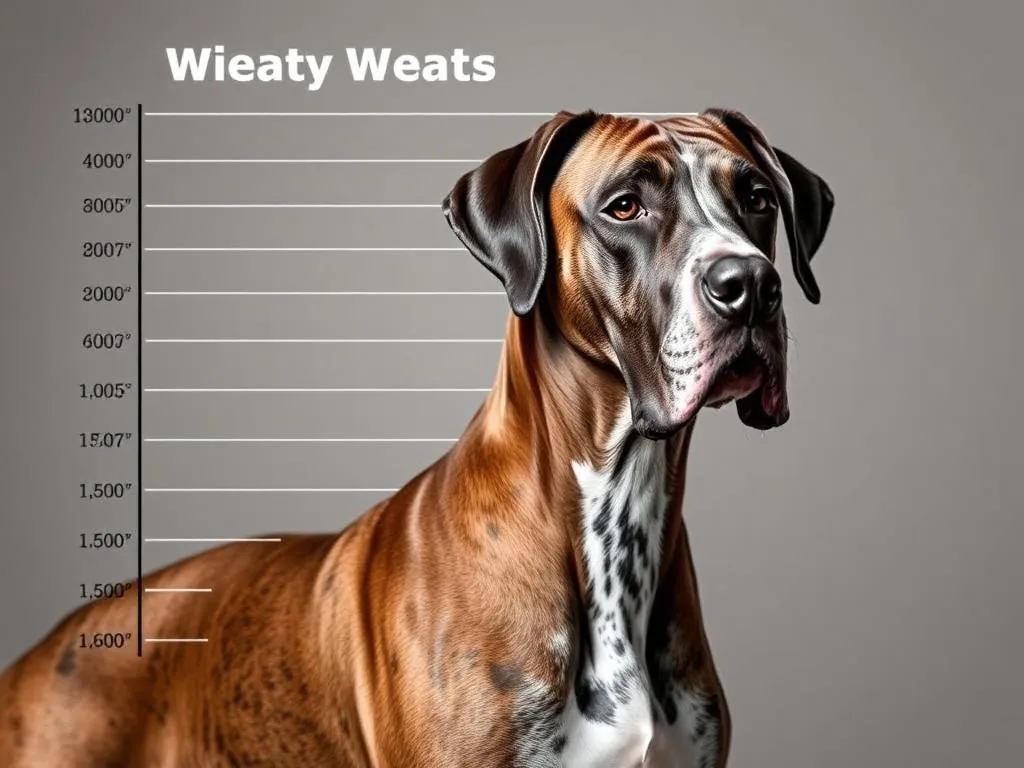
Introduction
The Great Dane, often referred to as the “gentle giant,” is one of the largest dog breeds in the world. Originating from Germany, this breed was initially developed for hunting large game such as wild boar. Over the years, they have transitioned into beloved family pets known for their friendly demeanor and protective nature.
Understanding the size, weight, and growth patterns of a Great Dane is crucial for both current and prospective owners. This knowledge not only helps in providing proper care but also ensures that the dog remains healthy as it grows. In this article, we will delve into the intricacies of Great Dane growth, size, and weight, complete with a detailed growth chart.
Understanding the Great Dane Breed
General Characteristics
Great Danes are known for their impressive stature and striking appearance. They typically have a strong, muscular build, which is complemented by their long legs and elongated necks. Their coats come in various colors—including fawn, brindle, blue, black, and harlequin—making each individual unique.
In terms of temperament, Great Danes are friendly, loyal, and protective. They are known to be excellent companions, getting along well with children and other pets. Their gentle nature, combined with their impressive size, makes them both a loving family member and a formidable guardian.
Common Health Issues
While Great Danes are generally healthy, they are predisposed to certain health issues. Some of the most common concerns include:
- Hip Dysplasia: This genetic condition can lead to arthritis and discomfort as the dog ages.
- Bloat (Gastric Torsion): A serious condition that can cause the stomach to twist, leading to life-threatening situations.
- Heart Problems: Great Danes are at risk for dilated cardiomyopathy, a condition that affects the heart’s ability to pump blood efficiently.
Understanding these potential health issues is vital for ensuring a long, healthy life for your Great Dane.
Growth Stages of a Great Dane
Puppy Stage (0-6 months)
During the puppy stage, which lasts from birth to about six months, Great Danes can experience rapid growth. They can gain several pounds each week, and it’s essential to monitor their growth closely. Proper nutrition is crucial during this period. A high-quality puppy food, rich in protein and calcium, is recommended to support their developing bones and muscles.
Socialization and training are also critical during these early months. Exposing your puppy to various environments, people, and other animals will help them develop into well-rounded adults. Basic commands and house training should also be prioritized during this stage to establish good behavior patterns early on.
Adolescent Stage (6-18 months)
The adolescent stage can be particularly challenging for Great Danes, as they undergo significant physical changes. They may experience growth spurts, and their coordination and strength can be unpredictable. This period is marked by behavioral changes, including increased energy levels and potential stubbornness.
Training should continue, focusing on reinforcement techniques to guide them through this challenging phase. Consistency is key, as adolescent Great Danes may test boundaries as they mature.
Adult Stage (18 months and onwards)
Once they reach 18 months, Great Danes typically reach their full physical size. At this point, maintaining a healthy weight becomes essential. Adult Great Danes require a balanced diet tailored to their size and activity levels. Regular exercise is also important to prevent obesity and promote overall health.
Routine veterinary check-ups should be scheduled to monitor health, weight, and any emerging concerns. Regular exercise routines will help keep them fit and can include walks, playtime, and other activities suited for their size.
Great Dane Size and Weight Overview
Average Size of Adult Great Danes
Great Danes are among the largest dog breeds, with males typically standing between 30 to 34 inches tall at the shoulder and females ranging from 28 to 32 inches. When it comes to weight, males generally weigh between 140 to 175 pounds, while females usually weigh between 110 to 145 pounds.
These size ranges can vary based on genetics, nutrition, and overall health. It’s important to note that individual dogs may fall outside of these ranges depending on their unique growth patterns.
Factors Influencing Size and Weight
Several factors can influence the size and weight of a Great Dane, including:
- Genetics: The lineage of the dog plays a significant role in its potential size. Puppies from larger parents are more likely to grow to a larger size.
- Nutrition: A balanced diet is crucial for proper growth and weight management. Overfeeding can lead to obesity, while underfeeding can stunt growth.
- Exercise and Lifestyle: Regular physical activity helps maintain a healthy weight and prevents health issues. A sedentary lifestyle can lead to obesity and other complications.
Great Dane Growth Chart
Importance of a Growth Chart
A growth chart is an essential tool for tracking your Great Dane’s development. It provides a visual representation of their height and weight at various ages, making it easier to identify growth patterns and potential health issues. By monitoring these trends, owners can make informed decisions about diet, exercise, and veterinary care.
Detailed Growth Chart
Here’s a sample growth chart for Great Danes, illustrating height and weight milestones from puppyhood to adulthood:
| Age (Months) | Height (Inches) | Weight (Pounds) |
|---|---|---|
| 0-2 | 12-14 | 5-10 |
| 3-6 | 18-24 | 25-50 |
| 6-12 | 24-30 | 50-90 |
| 12-18 | 26-34 | 90-175 |
| 18+ | 28-34 | 110-175 |
This chart provides an average range, and individual dogs may vary. Regularly measuring your Great Dane against this chart can help ensure they are on track.
Interpreting the Growth Chart
When using the growth chart, it’s crucial to compare your dog’s measurements to average values. If your Great Dane falls significantly below or above the expected range, it may indicate a need for dietary adjustments or a veterinary consultation.
For example, if a 12-month-old Great Dane weighs significantly less than 90 pounds, it may require a change in diet or an evaluation for potential health issues.
Caring for Your Great Dane’s Growth
Nutrition Guidelines
Providing appropriate nutrition at each growth stage is vital for a Great Dane’s development. Puppies need a high-quality diet specifically formulated for large breeds to support their rapid growth. As they transition to adulthood, the dietary focus should shift to maintenance food that helps prevent obesity.
Portion control is also essential. Overfeeding can lead to rapid growth, which may increase the risk of joint problems and bloat. It’s best to consult with a veterinarian to determine the best feeding schedule and portion sizes based on age, weight, and activity level.
Exercise Recommendations
Great Danes require regular exercise to maintain their health. For puppies, short bursts of playtime and gentle walks are ideal, while adults benefit from longer walks and more vigorous activities. However, it’s crucial to avoid over-exertion, especially during the growth stages, as their joints and bones are still developing.
Regular Health Check-ups
Routine veterinary visits are essential during a Great Dane’s growth phases. Regular check-ups allow for monitoring of weight, health, and vaccinations. Preventive care can catch potential health issues early, ensuring your Great Dane has the best chance of a long, happy life.
Conclusion
The journey of a Great Dane from puppyhood to adulthood is marked by significant growth and development. By understanding their size, weight, and growth patterns, owners can provide the best care possible. Regular veterinary visits, proper nutrition, and consistent training will help ensure that your Great Dane remains healthy and happy throughout their life.
Whether you’re a current Great Dane owner or considering bringing one into your home, being informed is key to providing the love and care these gentle giants deserve.








